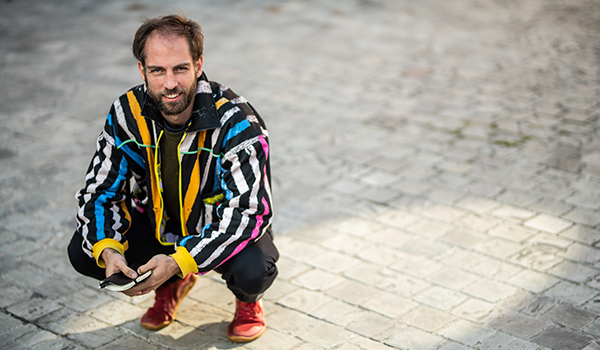London International Mime Festival (LIMF) is back early next year to bring contemporary circus, physical theatre, mime, puppetry and live art across London. This 47th edition comprises national premieres and some awaited returns, like Alexander Vantournhout. The Belgian dance and circus artist made his UK debut at the 2016 festival. Six years later, we spoke with Alexander about returning to LIMF and creating Through the Grapevine, an unusual pas-de-deux where two bodies dialogue around one another’s strengths and limits.
RR: Through the Grapevine is an unconventional pas-de-deux. What is disruptive about this duet?
Alexander: Traditionally, a pas-de-deux consists of a solo for each dancer, concluding in a duet. But in Through the Grapevine, we are connected all the time. As a result of spending quite some time in the studio, just the two of us. During the Covid crisis and lockdown, we had very little interaction with other people, which made us develop particular habits and move with one another.
RR: This is your seventh creation. What is persisting in your research for this piece, compared to your previous works?
Alexander: I am always interested in talking through the body, with the body talking about subjects one can only express through the body. How can one express love more concretely then with a subtle gesture, a touch, a handshake, a gaze… How can one depict death better than with a body, through movement and stillness? Words often seem to lack, in my opinion. These subjects seem difficult to grasp with words only.
RR: What physical challenges worked as premises to develop Through the Grapevine?
Alexander: We deal with the proportions of the body. Axel, my partner in crime, and I have identical height, nevertheless very different structure. His wingspan is 14cm longer than his height. On the other hand, I have a wingspan shorter than my height, but my neck is longer. Yet, I have a shorter trunk and limbs. Therefore, when standing in front of each other, he can touch me with his hands, while I can barely reach him.
The challenge was to make movement material deriving from this subject, creating agency from the concept of disproportions. Axel guides from the limbs as he has more reach. I can take the lead when the movement initiates from the torso or head. We had to reset our instincts about initiating movement. We needed to repattern the leading-following. Furthermore, what seemed so obvious to us – these differences in proportions – were not that easy to read for the spectator. So, how to extrapolate this nerdy body research was a big challenge.
RR: Physical contact is central in this performance. Is touch guiding the narrative, or is it just an element?
Alexander: During the creation process, we held on to this pas-de-deux concept and also developed some solo material. Lockdown was such a rupture that we felt that, on this project, we had to be fifty-five minutes in touch. We are always connected, interrelated, in balance, or balancing, presenting the spectator with one body that consists of two heads.
RR: What is the word that sums up the aesthetics of Through the Grapevine?
Alexander: Symmetry, in every way one can imagine. It’s present in the scenography, as well as in our choreography. We flux from point symmetry to radial symmetry to pseudo bilateral symmetry – just like a lobster with one big arm and a shorter arm symmetry on the vertical and horizontal line. It has been an obsession to lift and be lifted symmetrically, to distribute the roles in the creation equally, and to fully communicate the different proportions of our bodies. We need the symmetry to make that clear.
RR: How do dance and circus languages complete each other?
Alexander: Dance offers thinking to choreograph, remember, count and derive all possibilities from one single movement logarithm. Circus and acrobatics enhance exploring the vertical line and the freedom to go upside down. It gives perseverance in the practice to repeat the same thing over and over.
RR: You made your UK’s debut at the London International Mime Festival in 2016. What are you most excited about returning to the festival?
Alexander: I remember the audience gave me direct feedback, like being surprised and verbalizing it during the show and more extensively feedback afterwards. This was both a surprise and encouragement for the next performances.
RR: What shouldn’t people miss at LIMF 2023?
Alexander: Many emerging young artists who showed their work in London Mime are now the big names of today. In this way, the festival is somehow prophetic. As this edition is now full of its magnitude again, after the pandemic years, the programmers Helen and Joseph had three years to prospect. I look forward to probably one of the best London Mime Festivals editions.
London International Mime Festival will run between the 16th of January and the 5th of February 2023, in multiple venues across London. You can find out more about the programme here.
